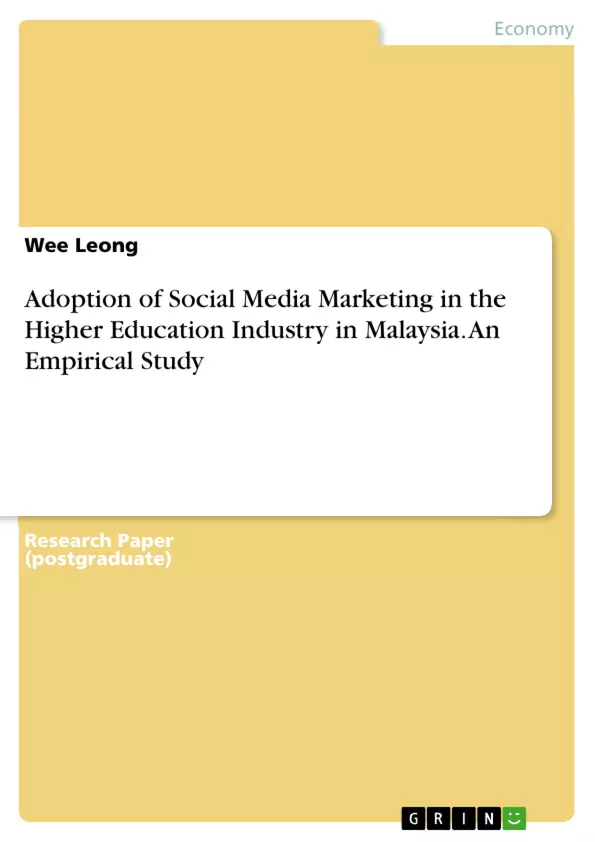With the introduction of personal computers, the Internet, and e-commerce have in fact created a tremendous impact on how businesses operate and market their products or services nowadays. The introduction of social media technology is accelerating and has become a trend for youngster and business partner today.
The purpose of this study was to investigate how social media marketing was implemented and adopted in the higher education institutions in Malaysia. Specifically, this study focused on the positive influence of using social media marketing and the benefits the Social Media Marketing system had provided to institutions which had accepted and utilized this new innovation. This study also aimed to determine the concern factors of adopting the Social Media Marketing system into current company management systems. An integral part of this research was to develop and to empirically test a model of the adoption of Social Media Marketing in the context of higher education institutions in Malaysia which based on the concepts of Rogers [2003] the Innovations Diffusion Theory (IDT), and Ajzen and Fishbein [1975] the Theory of Reasoned Action (TRA).
This research used a questionnaire to assess the higher education institutions in Malaysia on their cognition and perspective of the relative advantage, compatibility, complexity, trialability and observability of the Social Media Marketing; as well as to assess their attitudes and subjective norm toward their behavioral intentions of using the Social Media Marketing system. Research findings revealed the attributes of innovations mentioned above were significantly positively associated with the adoption of Social Media Marketing. According to the research results, managerial implications and opportunities for future research were discussed.
Inhaltsverzeichnis (Table of Contents)
- Introduction
- Literature Review
- Defining Social Media & Social Networking
- What is Social Media Marketing?
- Benefits of Social Media Marketing
Zielsetzung und Themenschwerpunkte (Objectives and Key Themes)
This study investigates the adoption of social media marketing in Malaysian higher education institutions. It examines the positive influences and benefits of social media marketing, as well as the challenges associated with its implementation. The research aims to develop and test a model for the adoption of social media marketing in this context, drawing on the Innovations Diffusion Theory (IDT) and the Theory of Reasoned Action (TRA).
- Adoption of social media marketing in Malaysian higher education institutions
- Positive influences and benefits of social media marketing
- Challenges associated with social media marketing adoption
- Development and testing of a model for social media marketing adoption based on IDT and TRA
- Impact of social media marketing on higher education institutions
Zusammenfassung der Kapitel (Chapter Summaries)
- Introduction: This chapter provides an overview of the study's context, focusing on the impact of social media on business practices and consumer behavior. It highlights the shift towards social relationships in business and the importance of engaging marketing strategies. The chapter discusses the growing significance of social media in Malaysia and the potential benefits for private education institutions.
- Literature Review: This chapter presents a comprehensive review of existing literature on social media, social networking, and social media marketing. It defines key concepts and explores the benefits and limitations of social media marketing. The chapter also examines the higher education industry in Malaysia and the role of social media in this sector. Finally, it outlines the fundamental theories that form the basis of the research model, including the Innovations Diffusion Theory (IDT) and the Theory of Reasoned Action (TRA).
Schlüsselwörter (Keywords)
This study focuses on social media marketing, its adoption in the higher education industry, and its impact on institutions in Malaysia. Key concepts explored include the Innovations Diffusion Theory (IDT), the Theory of Reasoned Action (TRA), private education, and social networking. The study aims to provide insights into the factors influencing the adoption of social media marketing in this specific context.
- Arbeit zitieren
- Dr. Wee Leong (Autor:in), 2018, Adoption of Social Media Marketing in the Higher Education Industry in Malaysia. An Empirical Study, München, GRIN Verlag, https://www.grin.com/document/424117



